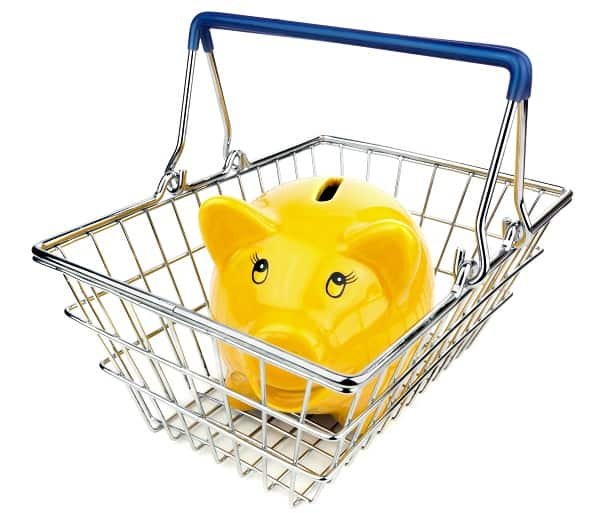We can all use some extra money at the end of the month. Imagine what it would mean if you were able to save yourself hundreds of dollars just by couponing. Couponing can feel overwhelming and you may have heard some myths that paint couponers in a negative light, but the truth is couponing is one of the easiest and most flexible ways to make ends meet for your family. In this blog post I will share my story of couponing and provide you with the steps and resources to start your couponing journey today.
I know couponing is a skill that can help families make ends meet, support local businesses, and give back to their communities.
My Story:
When I was growing up, my mom would coupon at the kitchen table and I loved helping her cut the coupons, collect the proof of purchases (especially for free toys!), and shop for the deals. Then my mom and I started watching SuperMarket Sweep in the afternoons and from that point on I was hooked at the ripe old age of three! Of course, being a “couponing” toddler, my mom had to deal with me being highly disappointed in her for buying anything without a coupon and for always refusing to dismantle store displays even though there was clearly a SuperMarket Sweeps bonus hanging there.
Time went on and my family and I moved away from couponing for a while. It seemed like too much effort, there were too many rules, and the coupons expired much too quickly for our hectic pace of life. Then I got married, and I started to worry about our financial stability. My husband and I both worked full time jobs that did not allow for a traditional part time job to supplement our incomes. I was trying to figure out a way to make more money and that is when I came back to my first love—couponing.
I started couponing in October 2015 and have not looked back. Couponing for me is a way to drastically save money on our household expenses and to give back to my community. As I am able to save so much with couponing I view it as a great part time job-I set my own hours, I can scale up or down the amount of couponing I am doing based on other demands in my life, and I don’t have to pay payroll taxes!

Couponing is also a way for me to volunteer and give back to my community. I struggled to find volunteer opportunities that allowed for time flexibility that I needed. With couponing I am able to connect with several local non-profit groups to donate food, hygienic supplies, and household items. Yes, it does cost money to donate these items, but I am able to get a lot of products for free or extremely cheap. As a rule, I will usually only purchase a donation item if it’s 25% or less of the original cost and I mostly donate hygienic products (i.e. soaps, make-up, shavers, feminine care) as those are not always covered by government subsidies. I simply add the deals to my shopping list, shop, store them in a designated bin in my house, and then monthly donate the items to the various groups.
GETTING LOCAL:
Couponing–when done ethically–also supports local businesses. It is a common myth that couponing hurts stores. This is not the case. If you use coupons correctly the store will be reimbursed by the manufacturer, and because you are using coupons you can now afford to shop at your local grocery store versus a big box store. Now there may be some cashiers that dislike coupons as they have to check that you are buying the correct products, scan them in, and occasionally fight with the register, but rest assured that you are not hurting the store by couponing responsibly.
WHAT YOU SHOULD KNow About Couponing:
Hopefully after reading my story you are ready to give couponing a try! Here are some of the things you need to know starting out:
- Time—It does take time to coupon. If I do a grocery haul where most of the items are from couponing and say I get 100 items (or a really packed cart) it takes about 1.5 to 2 hours for me to find the deals, gather my coupons and list, shop for the items, and then process the rebates and double check my receipt. A pharmacy couponing trip with a few hundred dollars of product is between 30 to 45 minutes.
The good news is you will get faster the more you coupon and you can scale how many stores you visit in a week. When I first started I couponed at seven stores—that’s crazy pants! Now I mainly coupon at Kroger (or their affiliates like Fred Meyer) and CVS. If there are great deals I may go to Walgreens or Rite Aid.Do not let the time commitment scare you away from couponing. When you see those savings start to come in you will find you are making quite a handsome hourly rate.
- Couponing is a virtual activity. In fact, if you can do a substantial amount of deals from your smartphone. If you are new to couponing, you may want to start out doing “digital only” deals before investing in a printer or newspaper coupons.
- You will need a pantry. While you do not need a massive stockpile like you see on TV, you do need to make a bit of room for extra food and bathroom supplies. After a few months you will learn the sale cycle and how much product your family uses, but it does help to have an extra cabinet or under the bed organizer for your items

“When you see those savings start to come in you will find you are making quite a handsome hourly rate.”
- It takes money to start couponing. You can get started with just the freebie deals, but to really see the substantial savings you need to have at least $50 that you can tie up in couponing. This will cover any money tied to store cash back programs or rebates. This amount will also allow you to buy extra products to build up your pantry.
- Expect to see a savings in your grocery budget after about three months of couponing. While you will see savings with each trip, it takes about three months for you to learn how to coupon, go through different sale cycles, and build your pantry. After three months you should have your $50 to support your couponing and be able to reduce your grocery budget going forward. After a year, you will know what is the best budget for your family and how low you can cut your grocery budget if necessary.
- Remember couponing is a learnable skill. Give yourself some time and grace to ease into couponing. Start at one store and maybe just do the store deals, then add in paper and online coupons, and then add in rebate apps. You will grow your confidence and not become overwhelmed.
How TO START COUPONING:
1. When you are ready to give couponing a try the first thing I recommend you do is find an online resource. There are hundreds of couponers on the web. You can search “Weekly Matchups at XYZ Store” or “Couponer XYZ Store in California.” There are websites, YouTube Channels (which I recommend), Facebook Groups, Instagram handles, and even Tik Tok dances to teach you how to coupon.
By investing the time up front to find a few online couponers that are trustworthy, provide realistic deals, have similar prices to where you live, and offer sales you are interested in, you will save yourself countless hours of work. These influencers typically provide a printable breakdown of the deals, are knowledgeable on the store’s coupon policies and changes, and best of all they will do the leg work of matching sales to coupons and rebates for you.
I have included a list of my favorite online couponers in this post. I also recommend the Krazy Koupon Ladies (app or website) as someone to not only get weekly deals from but also tips and how-tos for couponing at different stores.
Click on the document preview to download a copy of my favorite online couponing resources.
2. Set a budget—it is easy to get caught up in couponing, make sure you have a budget and an easy way to track your spending. Transfer money like you would a bill and then spend only from that account or envelope. This way you are forced to use any rebates, cash back, or store credits and you won’t be tempted to buy unnecessary items.
3. If you prefer paper coupons, start buying the Sunday paper. I recommend you buy two papers a week unless there is a really great coupon or it’s the first paper of the quarter (January, April, July, and October) in which case I buy four.
4. If you have a printer, consider printing coupons on Sunday or Monday from Coupons.com or another reliable source.
5. Always coupon ethically! When in doubt skip a deal because it is not worth hurting the store or committing coupon fraud. This means:
- Only use genuine coupons that have not expired—never copy or print off multiple coupons. If you are allowed two prints per coupon (which is standard) you will need to reclip the coupon and print again. Coupons are barcoded, serialized, and most are watermarked to prevent fraud.
- Make sure your product matches the coupon in terms of size, brand, and variety. NOTE: It does not need to match the picture, but rather the written specifications.
- Read the fine print on the coupon. This can be confusing as a new couponer what you need to pay special attention to is the verbiage around limits :
When it says “Limit of One Coupon Per Purchase” that means you can only use one manufacturer coupon per product. For examples: if you have 2 Tide coupons that you want to use you need to buy 2 bottles of Tide. You cannot use 2 coupons on 1 bottle of Tide.
This only applies to the manufacturer coupons. Your store may offer an additional store discount which then could be added. You will need to check your store’s policy and look to online couponer sources for guidance.
After the Limit of 1 Per Purchase the coupon may also read something like “Limit of 2 identical coupons per person/trip/household per day.” This means you can only use this many coupons regardless of how many items you buy and you do not want to try and cheat the system.
Just purchase this amount and if you need to, return another day to buy more of the item. These limits help prevent fraud and shelf clearing. You will also want to check your store’s policy for a limit of identical coupons. Most stores have a limit of four identical coupons per trip.
Read your store’s coupon policy which can be found online or at customer service, and when in doubt ask the cashier.
6. Go coupon! You are ready to get out there and get those deals for your family.
2. Set a budget—it is easy to get caught up in couponing, make sure you have a budget and an easy way to track your spending. Transfer money like you would a bill and then spend only from that account or envelope. This way you are forced to use any rebates, cash back, or store credits and you won’t be tempted to buy unnecessary items.
3. If you prefer paper coupons, start buying the Sunday paper. I recommend you buy two papers a week unless there is a really great coupon or it’s the first paper of the quarter (January, April, July, and October) in which case I buy four.
4. If you have a printer, consider printing coupons on Sunday or Monday from Coupons.com or another reliable source.
5. Always coupon ethically! When in doubt skip a deal because it is not worth hurting the store or committing coupon fraud. This means:
- Only use genuine coupons that have not expired—never copy or print off multiple coupons. If you are allowed two prints per coupon (which is standard) you will need to reclip the coupon and print again. Coupons are barcoded, serialized, and most are watermarked to prevent fraud.
- Make sure your product matches the coupon in terms of size, brand, and variety. NOTE: It does not need to match the picture, but rather the written specifications.
- Read the fine print on the coupon. This can be confusing as a new couponer what you need to pay special attention to is the verbiage around limits :
When it says “Limit of One Coupon Per Purchase” that means you can only use one manufacturer coupon per product. For examples: if you have 2 Tide coupons that you want to use you need to buy 2 bottles of Tide. You cannot use 2 coupons on 1 bottle of Tide.
This only applies to the manufacturer coupons. Your store may offer an additional store discount which then could be added. You will need to check your store’s policy and look to online couponer sources for guidance.
After the Limit of 1 Per Purchase the coupon may also read something like “Limit of 2 identical coupons per person/trip/household per day.” This means you can only use this many coupons regardless of how many items you buy and you do not want to try and cheat the system.
Just purchase this amount and if you need to, return another day to buy more of the item. These limits help prevent fraud and shelf clearing. You will also want to check your store’s policy for a limit of identical coupons. Most stores have a limit of four identical coupons per trip.
Read your store’s coupon policy which can be found online or at customer service, and when in doubt ask the cashier.
6. Go coupon! You are ready to get out there and get those deals for your family.

Additional Free Resources
Coupon Spending Tracker—Once you find the deals keep track of them so you know what to expect at the store and how much money to expect back from claimed rebates. You can also use this as a shopping list, a way to check you have all the coupons and cash back deals you need before you go, and a price tracker so you know if you are getting the best deal on a product. Claim your free copy of the Coupon Spending Tracker by signing up for the newsletter here.
Coupon With Me—These are free workshops that I am hosting where you can come with your deals and ask any questions that you may have. This is great for beginners as it allows you to double check your deals and gain that extra boost of confidence to go out and get those deals. Register for our next event by clicking here.
Your Turn!
Please leave a comment below on where you are in your couponing journey. If you are new to couponing, what additional questions do you have? I look forward to hearing from you!





